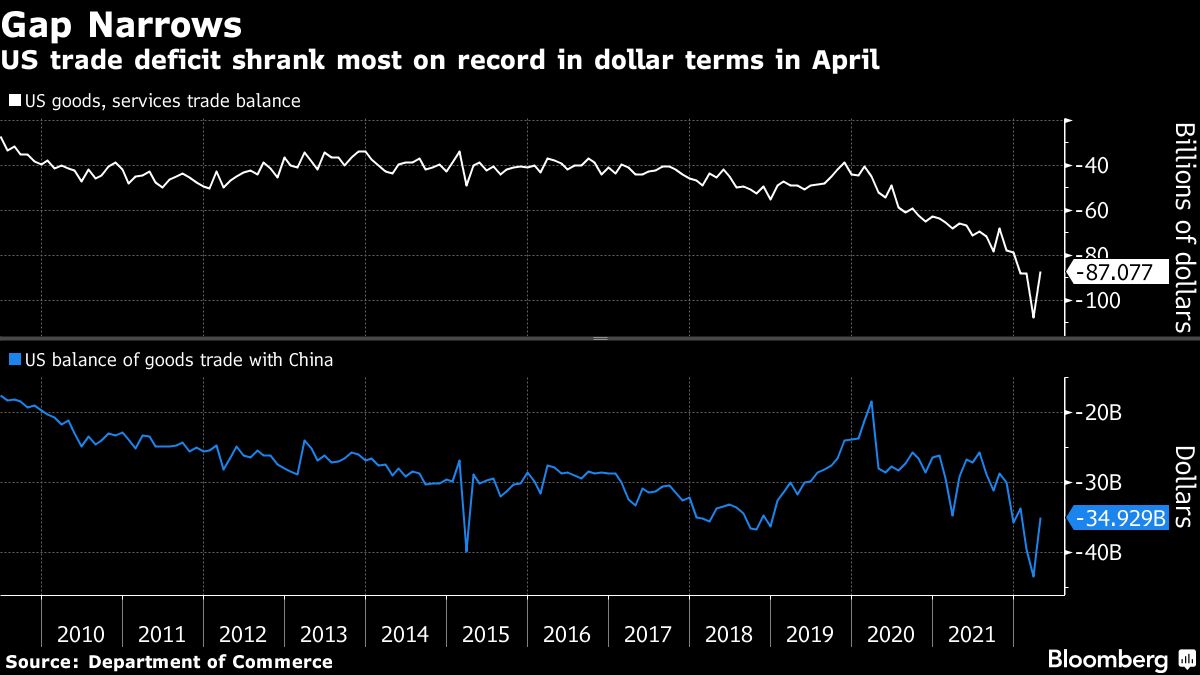The U.S. trade deficit shrunk in April by the most on record, in dollar terms. This reflects both a drop in the value of imports amid Covid lockdowns in China and growth in U.S. exports.
The gap in goods and services trade narrowed $20.6 billion, or 19.1 percent, to $87.1 billion, Commerce Department data showed Tuesday. The median estimate in a Bloomberg survey of economists called for an $89.5 billion deficit. The figures aren't adjusted for inflation.

Recommended For You
Imports dropped in April as factory activity in China fell to the lowest level since February 2020 amid strict lockdowns to curb the spread of Covid-19. While manufacturing in the country has improved somewhat since, the measures are still straining already-tenuous global supply chains, especially when coupled with Russia's war in Ukraine.
The deficit with China decreased in April by $8.5 billion, the most in seven years. Imports dropped $10.1 billion, also the most since 2015.
Decades-high inflation is expected to weigh on trade this year, with the World Trade Organization (WTO) cutting its forecast for growth in global merchandise volumes. So far though, that hasn't materialized yet in the U.S., judging by the near-record amounts of goods that arrived at the ports of Los Angeles and Long Beach in April.
In the first quarter, the widening of the trade deficit largely explained the economy's worst performance since the pandemic recovery began, with GDP shrinking at a 1.5 percent annual pace. That's because the value of products that American businesses and consumers bought from overseas outpaced purchases of U.S. goods and services by other economies.
Economists don't expect another contraction in the second quarter. If anything, a sustained narrower deficit—helped by growth in real net exports—should make a positive contribution to GDP, said Rubeela Farooqi, chief U.S. economist at High Frequency Economics.
"Overall, supply-chain dislocations and shortages have persisted, but exports and imports remain historically high," Farooqi said in a note. "The gap between the two is well above the pre-pandemic trend, a trend that is likely to continue for now."
The value of imports of goods and services decreased 3.4 percent in April, to $339.7 billion, the first drop since July in a broad-based decline. Exports increased 3.5 percent, to a record $252.6 billion. U.S. merchandise imports plunged from a record in March, dropping 4.4 percent (the most since April 2020), reflecting a decline in inbound shipments of consumer goods, industrial supplies, capital goods, and automobiles.
Retailers like Target Corp. and Walmart Inc. are trying to offload excess inventory, accumulated in part as consumers shift more of their spending from goods to services. That may portend fewer imports going forward.
On an inflation-adjusted basis, the April merchandise-trade deficit narrowed 14.2 percent, to $116.2 billion.
—With assistance from Kristy Scheuble.
© Touchpoint Markets, All Rights Reserved. Request academic re-use from www.copyright.com. All other uses, submit a request to [email protected]. For more inforrmation visit Asset & Logo Licensing.



